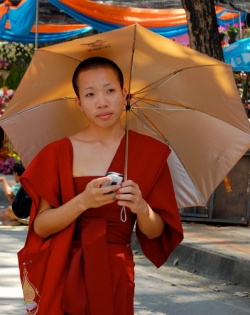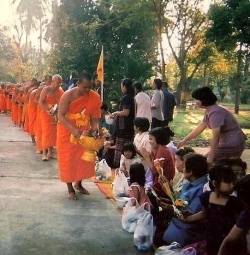PRĀPTI
Prāpti is one of the 14 citta-viprayukta-saṃskāra-dharmas mentioned in the Pañcaskandhaprakarana,
1 a text of the Yogacāra School. The Abhidharmakośabhāṣya, a monumental work of the Sarvāstivāda School, also lists it in the same category of the dharmas.
2 Both the works are by the same author – Ācarya Vasubandhu. Ven. KL. Dhammajoti considers prāpti as the most important dharma of this category.
3 This category of dharmas is unique to the Vaibhāṣika and the Yogacāra schools of Buddhism.
The Sautrāntika though advocates the theory of seed (bīja), which as we shall see later is seen as one of the functions of prāpti, it rejects the concept of prāpti as a real dharma. In this short essay I shall discuss the concept of prāpti, its characteristics and functions. Followings are some of the definitions of prāpti as found in different Sarvāstivāda and Yogacāra texts. In the Pañcaskandhaka, Vasubandhu defines prāpti as follows: What is prāpti? It is obtainment/attainment and endowment. According to circumstances that again is seed, control and proximity.
4 The Abhidharmakośabhāṣya presents following definition of prāpti: ‘Prāpti is acquisition and possession’5 – (praptirlābhaḥ samanvayaḥ).
6 The Abhidharmāvatāra defines it in the following manner: ‘Acquisition (prāpti) is the cause (kāraṇa) which permits the affirmation: “one is in possession of a certain dharma (dharmavat).”
There are three kinds of dharmas: pure (śubha), impure (aśubha) and non-defined (avyākṛta). The pure dharmas comprise faith etc.; the impure, greed, etc.; and the non-defined, the mind of transformation (nirmāṇacitta), etc. One who possesses [any of] these dharmas is said to be “in possession of the dharma”. The cause of certitude for such an assertion is named acquisition (prāpti), obtainment (lābha, pratilābha/pratilambha), and endowment (samanvāgama).’7 In all the above definitions of prāpti, its two characteristics are obvious.
They are
1) obtainment or acquisition (pratilambha) and
2) endowment or possession (samanvāgama).
The distinct functions of the two characteristics are well presented in both the Abhidharmakośabhāṣya and the Abhidharmāvatāra. According to them the prāpti is called acquisition because it acquires that which is not yet obtained. And again it is called possession because it possesses that, which after being obtained, sustains.9 Apart from these two characteristics the Pañcaskandhaka mentions three other aspects of prāpti, namely: bīja (seed) vaśitā (control), and sammukhībhāva (proximity). These three aspects as such are not discussed either in the Abhidharmakośabhāṣya or in the Abhidharmāvatāra.
We however, find the discussion on bīja (seed) by the Sautrāntikas in the Abhidharmakośabhāṣya. According to them ‘seed’ is consisted of the nāma-rūpa, and is a force that is capable of generating a result in a series at the culminating point of its evolution (pariṇāma-viśeṣa). However, the function of seed in prāpti, as we shall see later, is not exactly the same.
The prāpti (and also aprāpti) functions with the conditioned dharmas of a particular personal series (santāna) of a living being, not with the conditioned dharmas of another living or nonliving being. It also functions with the unconditioned dharmas such as pratisaṃkhyānirodha and apratisaṃkhyānirodha of a living being.
The Sarvāstivādin maintains like all other dharmas, prāpti and also aprāpti are real entities. Though they are called citta-viprayukta-saṃskāras because they are not associated with the mind, they are also actually not associated with the form. And it is precisely because of this that they can function with the dharmas of both categories – rūpa and citta. As we have seen in the Abhidharmāvatāra-definition]] of prāpti it acts as a cause for the possession of a dharma to a personal series. The dharma can either be pure, impure or nondefined. When a particular dharma is present in a particular series it is due to the force of its prāpti.
As for example a dharma such as ‘jealousy’ comes to be linked with me due to the force of prāpti. It exists in me even when the moment of ‘jealousy’ is replaced by another dharma such as ‘kindness’ etc. It will be delinked from me only when I am able to develop a very strong insight in me. Then a new prāpti of another dharma will arise which will act as a cessation of the previous dharma and to delink that same dharma from the personal series an aprāpti will also arise. Thus the prāpti of cessation of the defilement and the aprāpti of the defilement ensure that this defilement will not arise any more. Because its force is completely uprooted.10
The three aspects of prāpti, namely seed, control, and proximity explain how certain dharma arises and maintains its continuity in a personal series. As it is enumerated in the commentary to the Pañcaskadhakaprakarana,11 seed is a type of specific force that gives rise to a particular dharma, which could be pure, impure or undefined, in a personal series. Until a seed of a specific dharma is completely removed from the series it will continue to generate that dharma whenever its conditions are there. Control or vaśitā is a force within prāpti that maintains the continuity of the arisen dharma. Proximity or sammukhībhāva is a stage when the prāpti of a dharma achieves its complete result or objective.12
However two opposite dharmas – kuśala and akuśala – cannot exist together nor do they arise successively in a series. Regarding this point P.S. Jaini says: “…prāpti [is] a force which controls the collection of a particular kind of element, and another saṃskāra called aprāpti which prevents such a collection. Thus for instance, when an akuśala-citta is followed by a kuśala-citta the latter is brought into operation by prāpti of the kuśala dharmas which is at the same time assisted by the aprāpti which prevents the rise of kuśala dharmas.”13
The Sautrāntika rejects prāpti as real existing entity. According to them it is a mere designation (prajñapti) not a real entity (dravya) in and of itself. They explain that when a dharma arises, it arises depending on certain conditions, and it perishes when those conditions are no more. If prāpti acts as a cause for a dharma to arise than that prāpti needs another prāpti to arise, thus the process would be endless.14
Prāpti is a very unique citta-viprayukta-saṃskāra discussed by the Sarvāstivadins and the Yogacārins. In the Sarvāstivāda it is understood with its two characteristics ‘obtainment’ and ‘endowment’. But in the Yogacāra it was further explained with its three aspects: seed, control, and proximity. It functions primarily with the conditioned dharmas, and also with certain unconditioned dharmas. It is neither connected with the mind nor connected with the form. But it is considered as a real dharma by the two schools. The Sautrāntika, however, denies it to be a real dharma and considers it a ‘designation’ or ‘concept’.
1 Vasubandhu’s Pañcaskandhaka (2008): p. 13-14.
2 The Abhidharmakośabhāṣyam, trans. by Pruden, vol. 1, p. 206. 3 KL. Dhammajoti (2010): p. 279.
4 Vasubandhu’s Pañcaskandhaka (2008), p. 14: Prāptiḥ katamā/ pratilambhaḥ samanvāgamaḥ/ sā punarbījaṃ vaśitā sammukhībhāvaśca yathāyogam//
5 The Abhidharmakośabhāṣyam, tr. by Pruden, vol. 1, p. 206.
6 http://fiindolo.sub.uni-goettingen.de/gretil/1_sanskr/6_sastra/3_phil/buddh/vakobhau.htm 7 KL. Dhammajoti (2008): p. 108.
8 Abhidharmakośabhāṣya, tr. by Pruden, vol. 1, p. 206.
9 Cf, the Abbidharmāvatāra, p. 109: This acquisition is of two kinds: (i) The obtainment (lābha, pratilambha), at the present moment of what has not been acquired (prāpta) or what has been lost (vihīna); (ii) the endowment (samanvāgama) of what has been obtained (pratilabdha) and not lost. Non- acquisition (aprāpti) is the contrary to this.
10 KL. Dhammajoti, p. 380.
11 The translation of the commentary is available in Artemus B. Engle’s book, ‘The Inner Space of Buddhist Practice’.
12 Artemus B.
13 S. Jaini Padmanabh, ‘The Sautrantika Theory of "Bija", Website: http://www.jstor.org/stable/609427, .Accessed: 28/02/2013.
14 See: Abhidharmakośabhāṣya, (trans. By Pruden) vol. I, p. 209-211
References:
1) Abhidharmakoshabhasyam of Vasubandhu, Vol. I, (1988): (translated from French to English) by Leo M. Pruden, Berkeley: Asian Humanities Press. 2) KL. Dhammajoti, Bhikkhu (2007): Sarvāstivāda Abhidharma, Hong Kong: Centre of Buddhist Studies.
3) KL. Dhammajoti, Bhikkhu (2008): Entrance into the Supreme Doctrine Skandhila’s Abhidharmāvatāra, Kong Kong: Centre of Buddhist Studies. 4) Jaini, Padmanabh S. (1959): The Development of the Theory of the viprayuktasaṃskāras, published in the ‘Bulletin of the School of Oriental and African Studies’, University of London, Vol. 22, No. 1/3 (1959), pp. 531-547. Collected from http://www.jstor.org/stable/609505. Accessed: 09/03/2013. 5) Jaini, Padmanabh
S. ‘The Sautrantika Theory of "Bija", published in the ‘Bulletin of the School of Oriental and African Studies, University of London, Vol. 22, No. 1/3 (1959), pp. 236-249. Collected from http://www.jstor.org/stable/609427. Accessed: 28/02/2013.
6) Engle, Artemus B. (2009): The Inner Science of Buddhist Practice, New York: Snow Lion Publication.
7) Anacker, Stefan (2005) 1984: Seven works of Vasubandhu, Delhi: Motilal Banarsidass Publishers Private Limited.
8) Xuezhu, Li and Steinkellner, Ernst (2008): Vasubandhu’s Pañcaskandhaka, Beijing: China Tibetology Publishing House.


